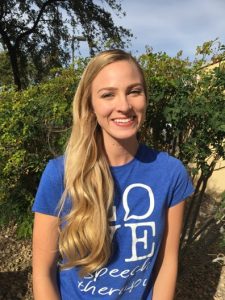Body Awareness is described as a person’s awareness of their body parts and knowing where their body is in a defined space. Body Awareness is important for children to learn to motor plan and coordinate their body parts through space and around objects in their environment.
Children with poor Body Awareness often appear uncoordinated or clumsy because they do not know where their body parts are. These children also have difficulty imitating movements, as they are unsure of where their body parts are and how to move them. New gross motor skills may be challenging for children with poor Body Awareness since they have difficulty processing proprioceptive input (the input we receive from our muscles and joints). Mirrors are tools for body awareness development and can be of assistance when learning new gross motor skills. Children visually compensate by using their vision to know where their body is in space.
When children with poor Body Awareness are asked to draw a picture of a person, they may exclude certain body parts or place in the incorrect location.
Body Awareness begins as early as 4-6 months; however as children grow, it is essential to help them become aware of their bodies. Occupational Therapists play an important role when working with children with poor Body Awareness by providing proprioceptive input, and carrying out gross and fine motor activities which incorporate posture, strength and dexterity. Below is a list of activities which help improve Body Awareness:
- Play the game “Simon Says”.
- Sing the songs: “Head, Shoulders, Knees and Toes”, and “Hokey Pokey”.
- Read the book: “Me and My Amazing Body” by Joan Sweeny for children ages 3 years and up.
- Play musical instruments and follow directions: “Make noise over your head”, “Behind you”, “To your right side”, etc.
- Have child seated on a gym ball, prone on gym ball, or on hands and knees and follow commands such as “Lift right leg” or “Raise right leg and left arm at the same time.”
- Give a verbal command and specify which body part to move a ball. For example: “Kick the ball with your right foot”, “Roll the ball with your left hand”, “Catch the ball with both hands”.
- Make an obstacle course using gross motor skills: Crawl through the tunnel, climb over the stool, jump on the right side of the “X” mark on the floor, etc.
- Give verbal command to touch specific body part to the environment. Examples include: “Touch the door with your right ear”, “Touch the wall with your left knee”.
- Cut out body parts of a person from construction paper, and have the child put the pieces together. Play the game “pin the body parts on the person” game after placing a picture of the head on the wall.
- Draw an incomplete picture of a person and have the child fill in the missing body parts.
- Use playdough, or putty to create a person or animal. Glue together pom poms to create a person or animal and glue plastic “wiggle eyes” on the face. Name the body parts for the child if necessary.
- Play “Build Matman” online game from “Handwriting Without Tears”. See Friday’s Blog Post for additional information!
*Can adapt the above activities for younger children by not specifying right and left. Can have child imitate movements versus following verbal commands.


